Page 326 of 424
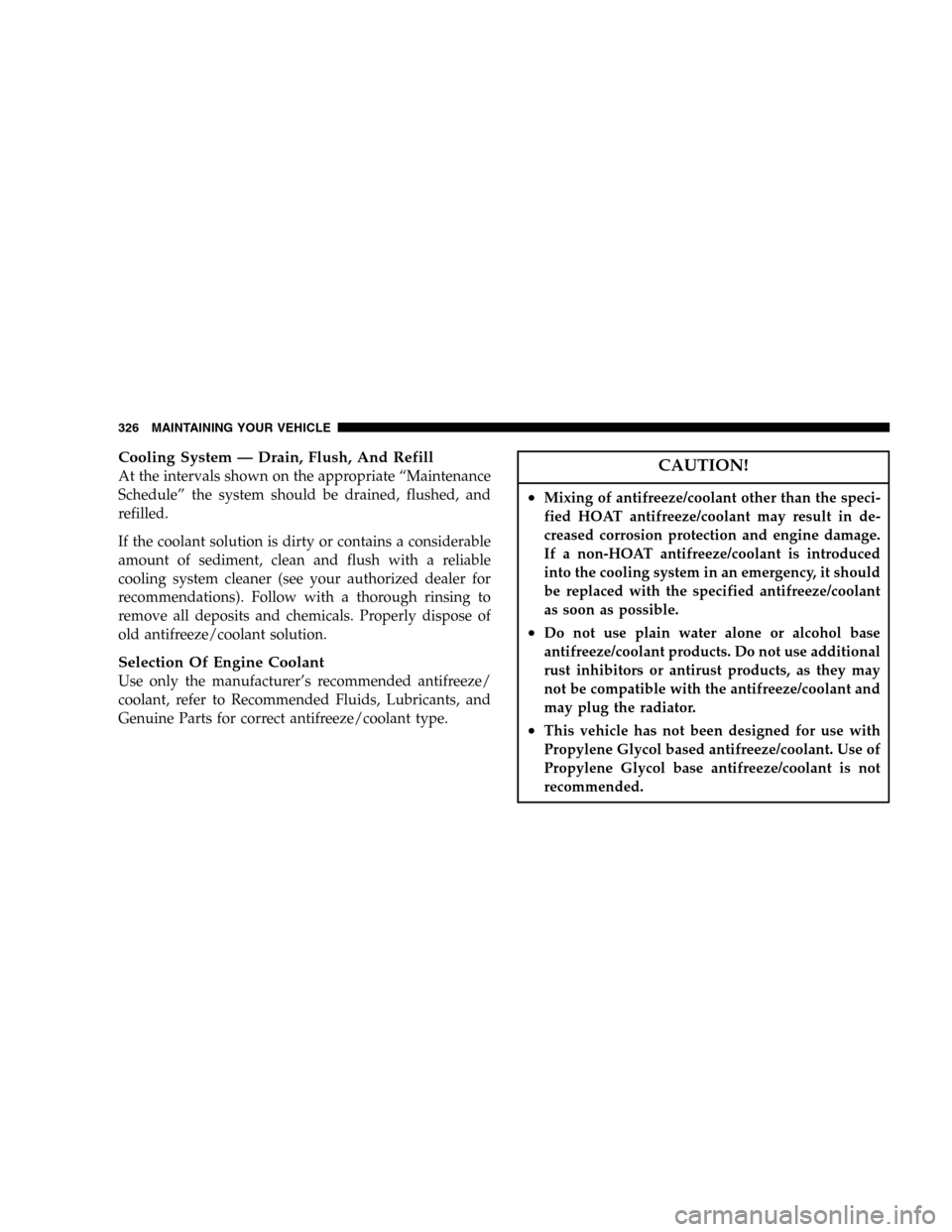
Cooling System — Drain, Flush, And Refill
At the intervals shown on the appropriate “Maintenance
Schedule” the system should be drained, flushed, and
refilled.
If the coolant solution is dirty or contains a considerable
amount of sediment, clean and flush with a reliable
cooling system cleaner (see your authorized dealer for
recommendations). Follow with a thorough rinsing to
remove all deposits and chemicals. Properly dispose of
old antifreeze/coolant solution.
Selection Of Engine Coolant
Use only the manufacturer’s recommended antifreeze/
coolant, refer to Recommended Fluids, Lubricants, and
Genuine Parts for correct antifreeze/coolant type.
CAUTION!
•Mixing of antifreeze/coolant other than the speci-
fied HOAT antifreeze/coolant may result in de-
creased corrosion protection and engine damage.
If a non-HOAT antifreeze/coolant is introduced
into the cooling system in an emergency, it should
be replaced with the specified antifreeze/coolant
as soon as possible.
•Do not use plain water alone or alcohol base
antifreeze/coolant products. Do not use additional
rust inhibitors or antirust products, as they may
not be compatible with the antifreeze/coolant and
may plug the radiator.
•This vehicle has not been designed for use with
Propylene Glycol based antifreeze/coolant. Use of
Propylene Glycol base antifreeze/coolant is not
recommended.
326 MAINTAINING YOUR VEHICLE
Page 330 of 424
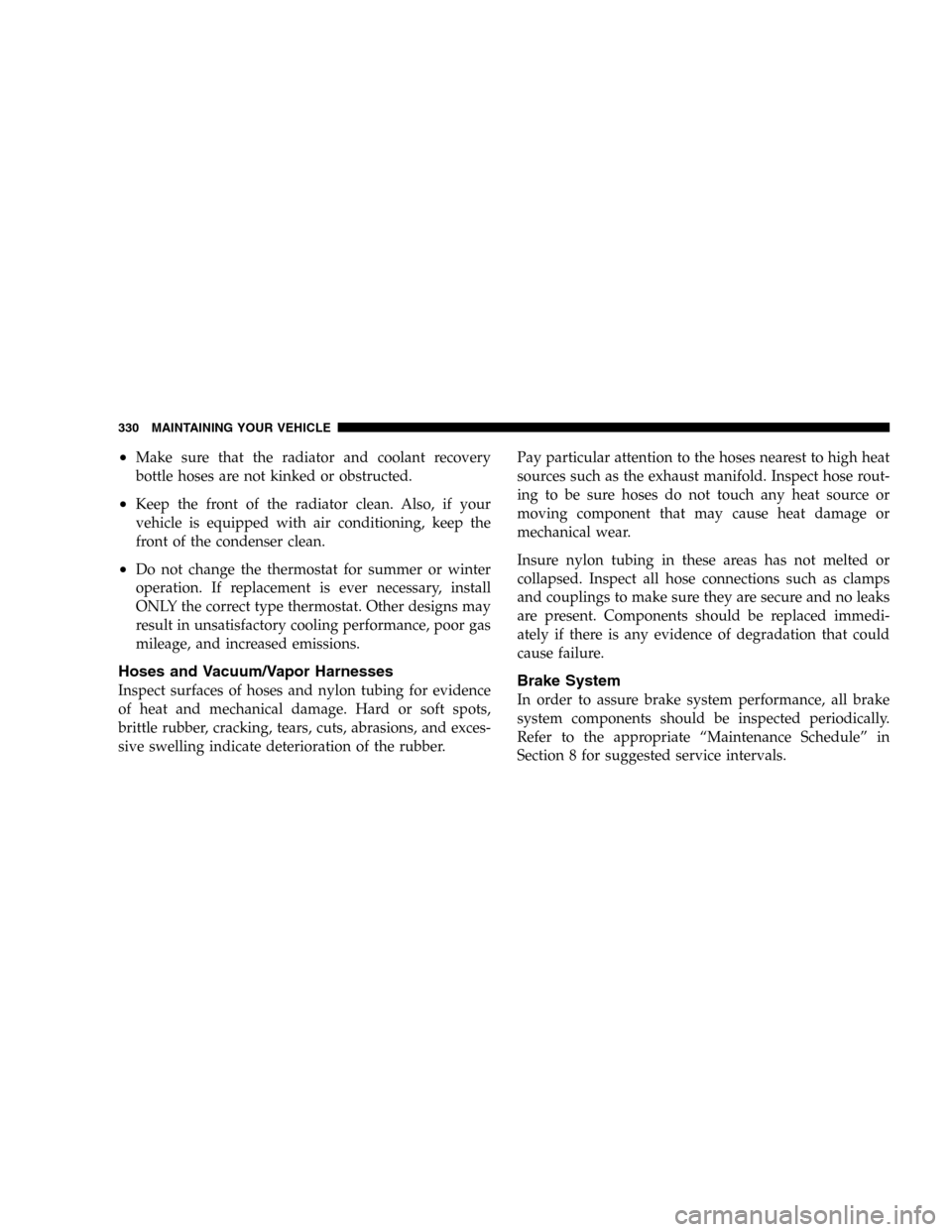
•Make sure that the radiator and coolant recovery
bottle hoses are not kinked or obstructed.
•Keep the front of the radiator clean. Also, if your
vehicle is equipped with air conditioning, keep the
front of the condenser clean.
•Do not change the thermostat for summer or winter
operation. If replacement is ever necessary, install
ONLY the correct type thermostat. Other designs may
result in unsatisfactory cooling performance, poor gas
mileage, and increased emissions.
Hoses and Vacuum/Vapor Harnesses
Inspect surfaces of hoses and nylon tubing for evidence
of heat and mechanical damage. Hard or soft spots,
brittle rubber, cracking, tears, cuts, abrasions, and exces-
sive swelling indicate deterioration of the rubber.Pay particular attention to the hoses nearest to high heat
sources such as the exhaust manifold. Inspect hose rout-
ing to be sure hoses do not touch any heat source or
moving component that may cause heat damage or
mechanical wear.
Insure nylon tubing in these areas has not melted or
collapsed. Inspect all hose connections such as clamps
and couplings to make sure they are secure and no leaks
are present. Components should be replaced immedi-
ately if there is any evidence of degradation that could
cause failure.Brake System
In order to assure brake system performance, all brake
system components should be inspected periodically.
Refer to the appropriate “Maintenance Schedule” in
Section 8 for suggested service intervals.
330 MAINTAINING YOUR VEHICLE
Page 331 of 424
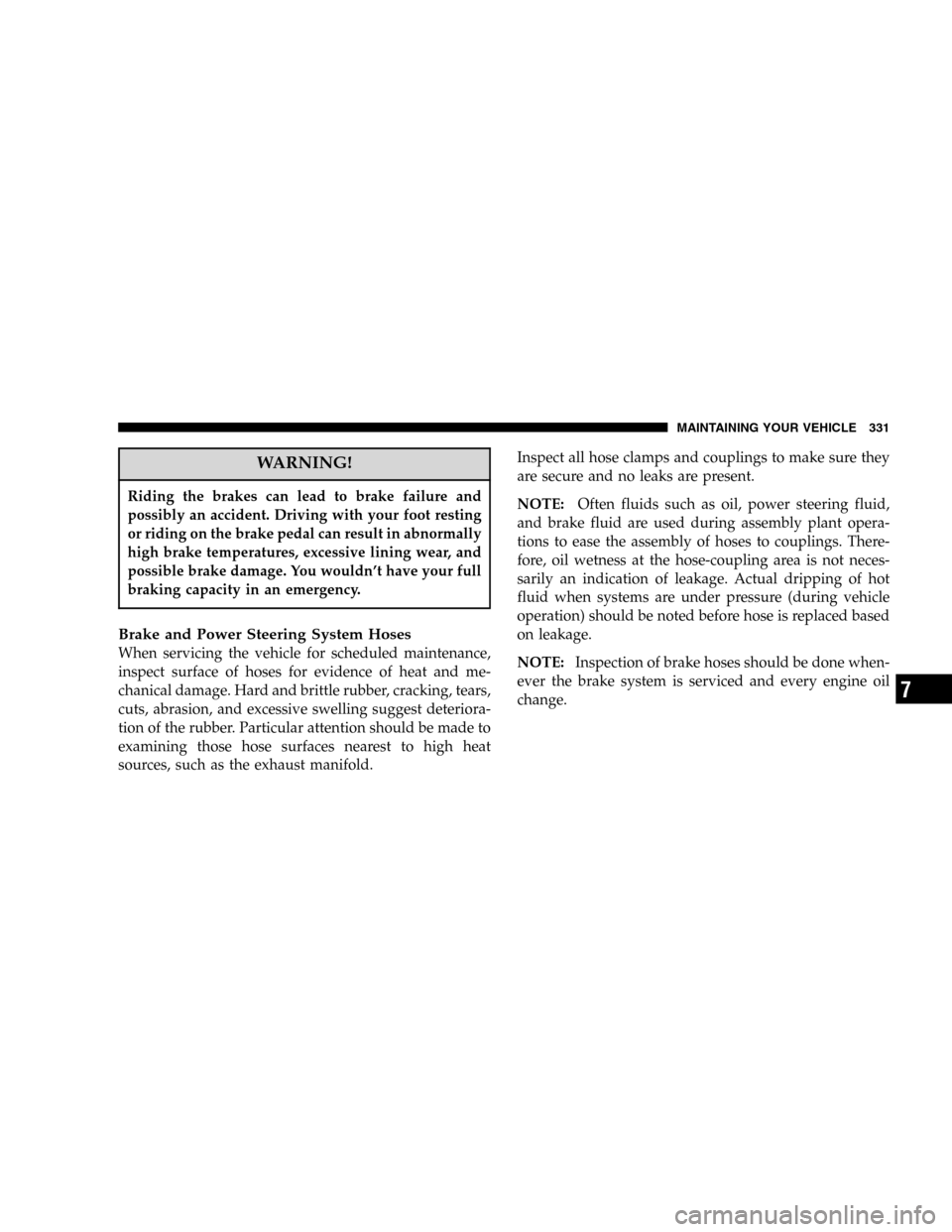
WARNING!
Riding the brakes can lead to brake failure and
possibly an accident. Driving with your foot resting
or riding on the brake pedal can result in abnormally
high brake temperatures, excessive lining wear, and
possible brake damage. You wouldn’t have your full
braking capacity in an emergency.
Brake and Power Steering System Hoses
When servicing the vehicle for scheduled maintenance,
inspect surface of hoses for evidence of heat and me-
chanical damage. Hard and brittle rubber, cracking, tears,
cuts, abrasion, and excessive swelling suggest deteriora-
tion of the rubber. Particular attention should be made to
examining those hose surfaces nearest to high heat
sources, such as the exhaust manifold.Inspect all hose clamps and couplings to make sure they
are secure and no leaks are present.
NOTE:Often fluids such as oil, power steering fluid,
and brake fluid are used during assembly plant opera-
tions to ease the assembly of hoses to couplings. There-
fore, oil wetness at the hose-coupling area is not neces-
sarily an indication of leakage. Actual dripping of hot
fluid when systems are under pressure (during vehicle
operation) should be noted before hose is replaced based
on leakage.
NOTE:Inspection of brake hoses should be done when-
ever the brake system is serviced and every engine oil
change.
MAINTAINING YOUR VEHICLE 331
7
Page 359 of 424
MAINTENANCE SCHEDULES
CONTENTS
�Emission Control System Maintenance........360
�Maintenance Schedules — Gasoline Engines....360
▫Schedule “B” — Gasoline Engines.........363
▫Schedule “A” — Gasoline Engines.........373�Maintenance Schedules — Diesel Engines.....378
▫Schedule “B” — Diesel Engines...........380
▫Schedule “A” — Diesel Engines...........385
8
M
A
I
N
T
E
N
A
N
C
E
S
C
H
E
D
U
L
E
S
Page 360 of 424
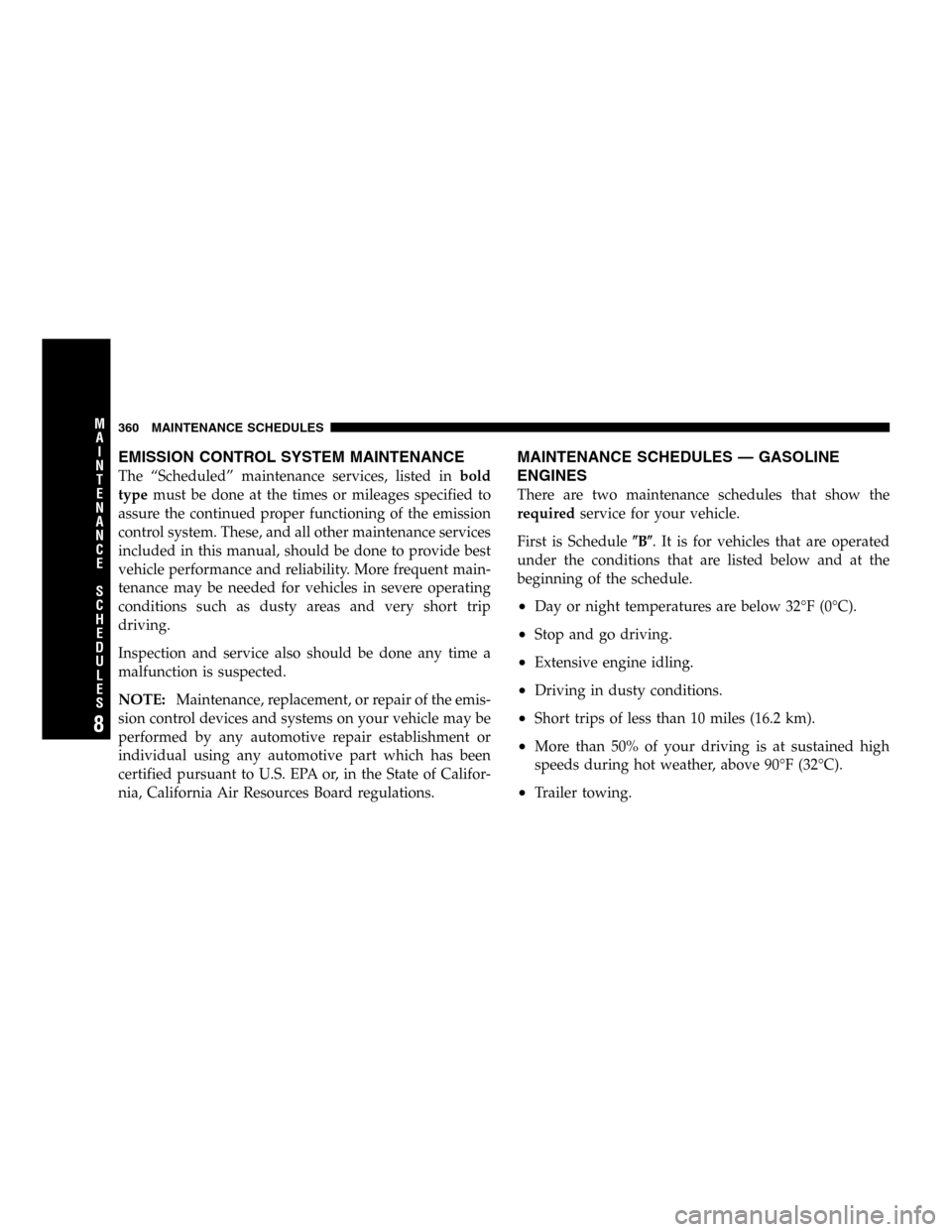
EMISSION CONTROL SYSTEM MAINTENANCE
The “Scheduled” maintenance services, listed inbold
typemust be done at the times or mileages specified to
assure the continued proper functioning of the emission
control system. These, and all other maintenance services
included in this manual, should be done to provide best
vehicle performance and reliability. More frequent main-
tenance may be needed for vehicles in severe operating
conditions such as dusty areas and very short trip
driving.
Inspection and service also should be done any time a
malfunction is suspected.
NOTE:Maintenance, replacement, or repair of the emis-
sion control devices and systems on your vehicle may be
performed by any automotive repair establishment or
individual using any automotive part which has been
certified pursuant to U.S. EPA or, in the State of Califor-
nia, California Air Resources Board regulations.
MAINTENANCE SCHEDULES — GASOLINE
ENGINES
There are two maintenance schedules that show the
requiredservice for your vehicle.
First is Schedule�B�. It is for vehicles that are operated
under the conditions that are listed below and at the
beginning of the schedule.
•Day or night temperatures are below 32°F (0°C).
•Stop and go driving.
•Extensive engine idling.
•Driving in dusty conditions.
•Short trips of less than 10 miles (16.2 km).
•More than 50% of your driving is at sustained high
speeds during hot weather, above 90°F (32°C).
•Trailer towing.
360 MAINTENANCE SCHEDULES
8
M
A
I
N
T
E
N
A
N
C
E
S
C
H
E
D
U
L
E
S
Page 361 of 424

•Taxi, police, or delivery service (commercial service).
•Off-road or desert driving.
•If equipped for and operated with E-85 (ethanol) fuel.
NOTE:IfANYof these apply to you then change your
engine oil every 3,000 miles (5 000 km) or 3 months,
whichever comes first and follow “Schedule B” of the
“Maintenance Schedules” section of this manual.
NOTE:IfANYof these apply to you then flush and
replace your engine coolant/anti-freeze every 102,000
miles (163 000 km) or 60 months, whichever comes first,
and follow “Schedule B” of the “Maintenance Schedules”
section of this manual.
NOTE:Most vehicles are operated under the conditions
listed for Schedule “B.”Second is Schedule“A”. It is for vehicles that are not
operated under any of the conditions listed under Sched-
ule “B.”
Use the schedule that best describes your driving condi-
tions. Where time and mileage are listed, follow the
interval that occurs first.
CAUTION!
Failure to perform the required maintenance items
may result in damage to the vehicle.
MAINTENANCE SCHEDULES 361
8
M
A
I
N
T
E
N
A
N
C
E
S
C
H
E
D
U
L
E
S
Page 362 of 424

At Each Stop for Fuel
•Check the engine oil level about 5 minutes after a fully
warmed engine is shut off. Checking the oil level while
the vehicle is on level ground will improve the accu-
racy of the oil level reading. Add oil only when the
level is at or below the ADD or MIN mark.
•Check the windshield washer solvent, add as required.
Once a Month
•Check the tire pressure and look for unusual wear or
damage.
•Inspect the battery, and clean and tighten the terminals
as required.
•Check the fluid levels of the engine coolant/anti-
freeze reservoir, brake master cylinder, and transmis-
sion, and add as needed.
•Check all lights and all other electrical items for correct
operation.
At Each Oil Change
•Change the engine oil filter.
•Inspect the exhaust system.
•Inspect brake hoses.
•Check the engine coolant/anti-freeze level, hoses, and
clamps.
•Inspect manual transmission fluid level, and for leaks
(if equipped).
•After completion of off-road operation, the underside
of the vehicle should be thoroughly inspected. Exam-
ine threaded fasteners for looseness.
362 MAINTENANCE SCHEDULES
8
M
A
I
N
T
E
N
A
N
C
E
S
C
H
E
D
U
L
E
S
Page 363 of 424
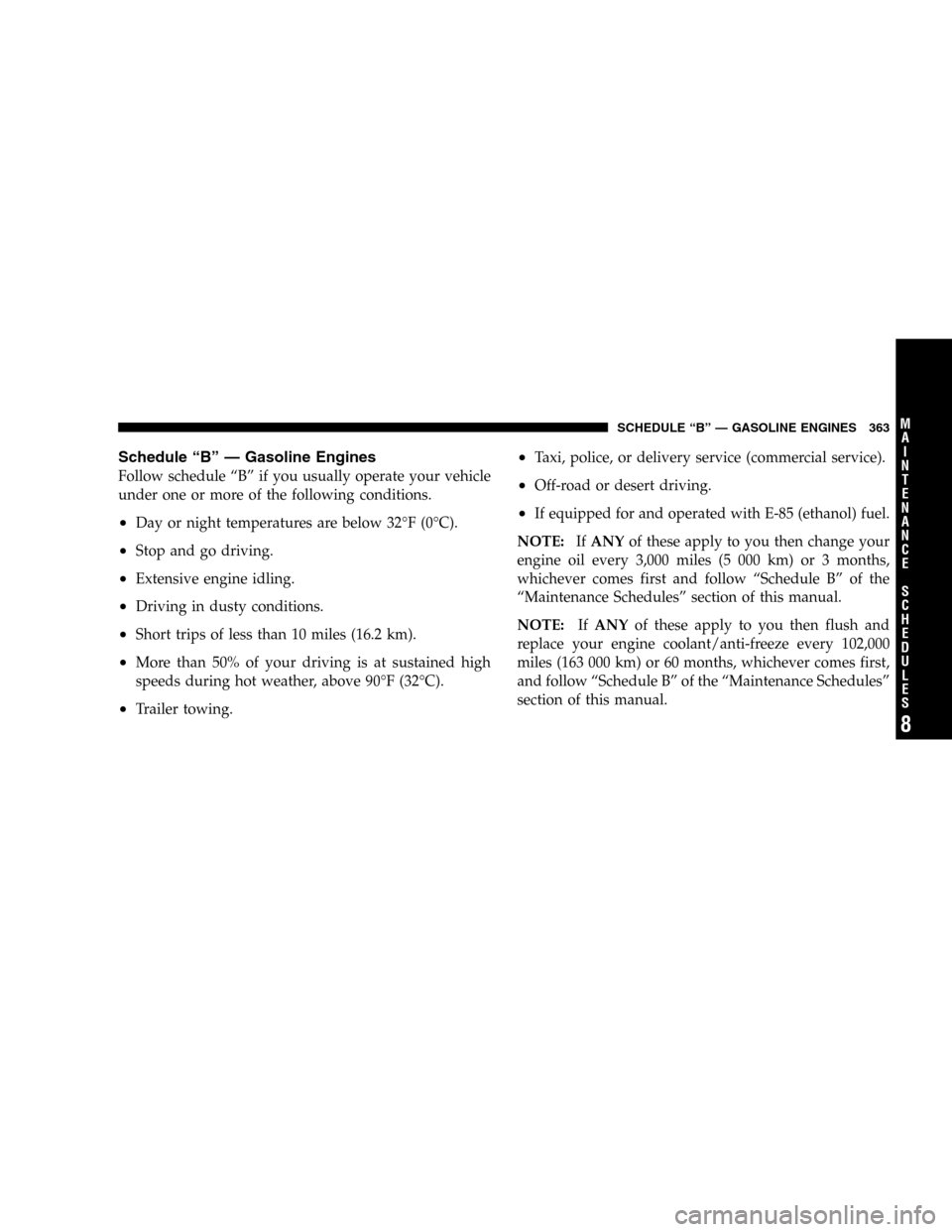
Schedule “B” — Gasoline Engines
Follow schedule “B” if you usually operate your vehicle
under one or more of the following conditions.
•Day or night temperatures are below 32°F (0°C).
•Stop and go driving.
•Extensive engine idling.
•Driving in dusty conditions.
•Short trips of less than 10 miles (16.2 km).
•More than 50% of your driving is at sustained high
speeds during hot weather, above 90°F (32°C).
•Trailer towing.
•Taxi, police, or delivery service (commercial service).
•Off-road or desert driving.
•If equipped for and operated with E-85 (ethanol) fuel.
NOTE:IfANYof these apply to you then change your
engine oil every 3,000 miles (5 000 km) or 3 months,
whichever comes first and follow “Schedule B” of the
“Maintenance Schedules” section of this manual.
NOTE:IfANYof these apply to you then flush and
replace your engine coolant/anti-freeze every 102,000
miles (163 000 km) or 60 months, whichever comes first,
and follow “Schedule B” of the “Maintenance Schedules”
section of this manual.
SCHEDULE “B” — GASOLINE ENGINES 363
8
M
A
I
N
T
E
N
A
N
C
E
S
C
H
E
D
U
L
E
S